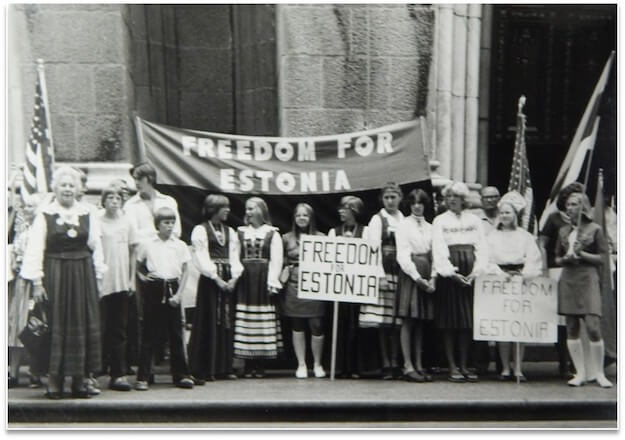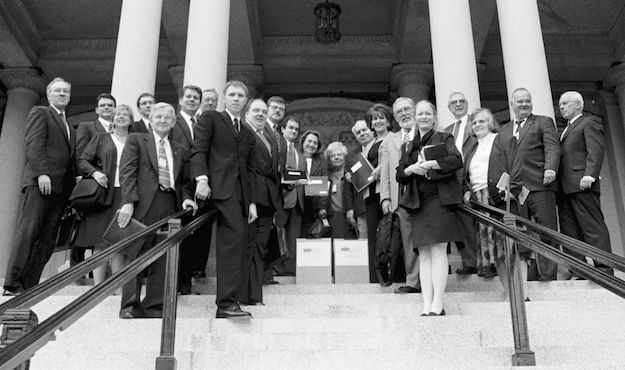
Captive Nations Week demonstration in New York, July 1977. Photo courtesy of the Estonian Archives in the U.S.)
As the newly-elected council takes their seats in November for the next four-year term, it seems like a good time to review how the Estonian American National Council (EANC) came about and some of its political accomplishments over the decades.
EANC was born in 1952 from the need for a single national organization to unify and lead Estonians exiled in the U.S. in their pursuit to restore Estonia as a free nation. It has a 66-year history of advocacy in the U.S. throughout the changing landscape of Estonia’s occupation, its struggle for independence, and its evolution into a partner on the world stage. Its founding aim was to coordinate efforts in fighting communism and liberating Estonia, along with the other nations trapped behind the Iron Curtain.
In the early years, Estonians who had come to the U.S. had fresh memories of the trauma
of the war, of the struggles of leaving, of family left behind, and of Estonia as a free nation. While still working to establish themselves in their new home country, many were motivated by strong feelings of injustice and purpose to engage with the U.S. government and the broader public, first just to educate them on where Estonia was, and second, to raise awareness that Estonia, and half of Europe, had unlawfully fallen under repressive Soviet rule. The 1940 Welles Declaration, issued by acting Secretary of State Sumner Welles, established the U.S. policy of nonrecognition of the Soviet annexation of the Baltic nations, and provided a foundation for EANC’s work.
Early advocacy successes tended to be more symbolic than substantial, and they often came from cooperation among groups of diaspora activists from many nations. Estonian Americans were active in groups like the Assembly of Captive European Nations (ACEN), which was formed in New York in 1954 with offices located intentionally across the street from the United Nations headquarters as a daily reminder to the global community of the ongoing occupations in Europe. It represented communities from nine captive nations (Albania, Bulgaria, Czechoslovakia, Estonia, Hungary, Latvia, Lithuania, Poland and Romania), and its goals were the peaceful liberation of their nations from communist rule – through educating public opinion on the realities of life behind the Iron curtain – and enlisting the cooperation and support of the U.S. and other governments and NGOs in working toward this liberation.
Estonian advocacy evolved over the next several years as Estonian activists became better
acquainted with the workings of Capitol Hill and more confident in their advocacy. In 1961, the first resolutions demanding action on Baltic freedom were introduced, calling on President Kennedy to initiate action in the UN to withdraw Soviet troops, return Baltic exiles, and conduct free elections in the nations.
1961 was also the year the Joint Baltic American National Committee (JBANC) was formed by its parent organizations, EANC, the American Latvian Association and the Lithuanian American Council. JBANC’s mission was to help coordinate the parent organizations’ activities in Washington, DC with the U.S. Congress and administration and its related agencies in conjunction with issues related to Estonia, Latvia, and Lithuania. Coordination and consolidation of advocacy for the common interests shared by the Baltic American communities formed the basis for much of EANC’s activism moving into the 1960s and beyond.
A significant moment came in 1975 when Baltic leaders were granted a meeting with President Ford to discuss their concerns over that year’s Helsinki Conference. The conference addressed European security issues and post WWII boundaries, and the Baltic communities, among others, were concerned that the U.S. policy of nonrecognition might change and the three counties might be permanently sold out to placate Moscow.
A protest was organized in DC that April and a crowd of over 4,000 gathered to send their message. Congress declared recess for the day so Members could speak at the rally, and Senator Bob Dole of Kansas was among the notable participants. Despite rumors that the U.S. would abandon the Welles Declaration, President Ford held his ground at the August convention and reaffirmed the policy, to the relief and celebration of the Estonian American community.
The 1980 Moscow Olympics brought another opportunity for activism. EANC led a grassroots letter campaign to protest the International Olympic Committee’s approval of Tallinn as the site for the games’ sailing competitions. The campaign noted that the Soviet government’s agenda included showing that Estonia’s annexation was a foregone conclusion, defying the principles of the Olympic Games and casting doubt on the Estonian people’s right to self-determination. While the primary basis for President Carter’s ultimate decision to boycott the games was the Soviet invasion of Afghanistan, he wrote a letter of thanks to the EANC president for Estonian American support, and in it, he cited the status of Estonia and issues concerning dissidents as factors that contributed to his decision.
As the 1980s progressed, there was a growing sense of urgency around getting results. The Estonian population was in decline and many felt they were becoming an endangered species. As Estonian American efforts intensified, Moscow pushed back by jamming western radio broadcasts, ironically prompting EANC to call on the White House to protest Soviet violation of the very Helsinki Accords that Baltic leaders had dreaded only a few years before.
The Reagan years finally began the process of real change that Estonian Americans had been fighting for. Baltic Americans in California had been strong supporters of Governor Reagan and quickly established ties with his White House staff. Legislation that called for his 1982 designation of June 14th as Baltic Freedom Day, commemorating the mass deportations of Baltic citizens in 1941, was another victory for Baltic advocacy.
The approaching 50th anniversary of the 1939 Molotov-Ribbentrop pact that divided Eastern Europe again raised awareness of the injustices that led to the annexation of the Baltic nations, leading to Black Ribbon Day observances by Estonian and Baltic communities around the U.S. EANC also worked during this time to focus Congress on the fate of imprisoned Estonian political dissidents, an issue that many Members of Congress increasingly spoke out against. The 1980s was a decade of mushrooming Estonian Americans activism that eventually led to its ultimate goal.
Once Estonia reestablished independence in 1991, EANC was involved in the transitional period, helping to form a temporary government structure in Tallinn and formally insisting on legal continuity of the original Estonian Republic. They demanded restoration of the terms of the 1920 Tartu Peace Treaty, in which Soviet Russia recognized the Republic of Estonia and renounced forever all rights over the nation, and which they clearly violated with their military occupation. EANC pushed Congress to call for removal of Soviet troops from Estonian territory and called on the U.S. government to provide assistance in establishing all key areas of the new democratic government.
One very important relationship that arose in the 1990s, through the work of the Department of Defense, EANC and the Baltimore Estonian Society, was the National Guard State Partnership Program between Estonia and the Maryland National Guard. These state partnership programs helped many newly independent nations establish their defense forces in the democratic model and provided instruction in all aspects of building military services in a democracy. They helped nations prepare for NATO membership by guiding them through their NATO membership action plans, and eventually evolved into the Offices of Defense Cooperation that still manage continuing cooperation programs. In the case of all three Baltic nations, such programs include building the necessary infrastructure and making other preparations to host NATO troops deployed under the Enhanced Forward Presence mission, as an example.
While throughout the 1990s and early 2000s, EANC’s main advocacy goal was NATO membership for Estonia, the fight for NATO membership didn’t just happen in the Baltics. Other new nations also wanted to join the alliance and saw advantages to pooling their resources. In 1994, the Central and East European Coalition (CEEC) was established by groups with common interests in the region. The coalition is made up of eighteen national, membership-based organizations representing Americans with heritage from twelve nations, including Armenia, Belarus, Bulgaria, the Czech Republic, Estonia, Georgia, Hungary, Latvia, Lithuania, Poland, Romania, Slovakia, and Ukraine. The Coalition serves as a liaison among these national ethnic organizations and cooperates in calling attention to issues of mutual concern, especially regarding U.S. policy toward the region. While the original goal was NATO membership (and remains so for at least two coalition members), the CEEC continues to collaborate in advocating in Congress, publishing coordinated statements on issues of concern, and hosting events on Capitol Hill to call attention to and inform Congressional staff on their issues.
EANC continues to maintain its active role in the coalition, in JBANC and in bilateral contacts with Congress, the Estonian Embassy in DC, the State Department, and other agencies in Washington foreign policy circles. The main topics currently discussed include continued support for NATO and the Defense Department’s European Deterrence Initiative funding, implementation of sanctions against Russia for interference in democracy and the sovereignty of its neighbors, energy security, and support for Ukraine. Another main topic with Senators and Representatives is membership in the Senate Baltic Freedom Caucus or House Baltic Caucus.

A group of Baltic American community representatives – including current EANC president Marju Rink-Abel (third from left) and EANC President at the time, Mati Kõiva (fifth from left) – delivering petitions to support NATO enlargement to the White House on Sept. 10, 2001.
Several resources have documented EANC’s history in great detail. The following references are available to those wishing to learn more about Estonian American life from the first migrations to the present.
EANC published a history book in 2016 titled Estonians in America 1945-1995: Exiles in a Land of Promise, which catalogs information on all aspects of the communities and organizations the Estonian diaspora in the U.S. established to keep alive the Estonian language and culture – including academic institutions, churches, schools and youth organizations – and also to engage in political advocacy from grassroots to national levels.
A major contributor to the Estonian cause in the U.S. is the newspaper of the Estonian American community, Vaba Eesti Sõna, or Free Estonian Word. The paper was founded in New York in 1949 and has been issued weekly ever since. It was essentially the sole source of news for Estonians in America, and published news from Estonia, on Estonian activities in the U.S., and news from communities in other countries. While serving as a valuable historical archive of events for research, it also played a crucial role in maintaining the cohesion of the Estonian diaspora, and it continues to do so, as a physical newspaper and in online form at www.vabaeestisona.com.
The Estonian Archives in the U.S., located in Lakewood, New Jersey also holds a vast collection of relevant material. They maintain a trove of photos, documents, publications, personal histories, and artifacts, acting as the keepers of Estonian American history and playing a monumental role in collecting and preserving all aspects of the diaspora’s story.
EANC has a proud 66-year history of supporting and representing the Estonian community in the U.S. The newly elected council, the 22nd, which will meet on November 3-4 in Philadelphia, will carry on the tradition while also adapting its approach to its mission as the community evolves. EANC will continue its role as a resource for Estonian Americans to help them maintain their cohesive communities, cultural activities, connections to their language and heritage, and political activism and looks forward to four years of great work.
Karin Shuey
Washington, DC
Director Estonian American National Council













